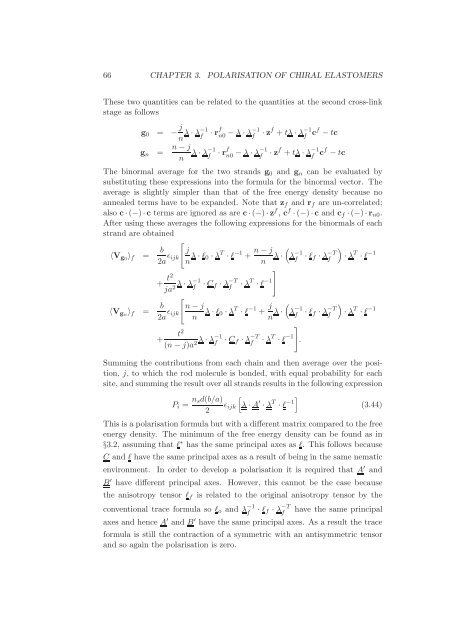Statistical models of elasticity in main chain and smectic liquid ...
Statistical models of elasticity in main chain and smectic liquid ...
Statistical models of elasticity in main chain and smectic liquid ...
Create successful ePaper yourself
Turn your PDF publications into a flip-book with our unique Google optimized e-Paper software.
66 CHAPTER 3. POLARISATION OF CHIRAL ELASTOMERSThese two quantities can be related to the quantities at the second cross-l<strong>in</strong>kstage as followsg 0 = − j n λ·λ−1 f·r f n0 −λ·λ−1 f·z f +tλ·λ −1f cf −tcg n = n−jn λ·λ−1 f·r f n0 −λ·λ−1 f·z f +tλ·λ −1f cf −tcThe b<strong>in</strong>ormal average for the two str<strong>and</strong>s g 0 <strong>and</strong> g n can be evaluated bysubstitut<strong>in</strong>g these expressions <strong>in</strong>to the formula for the b<strong>in</strong>ormal vector. Theaverage is slightly simpler than that <strong>of</strong> the free energy density because noannealed terms have to be exp<strong>and</strong>ed. Note that z f <strong>and</strong> r f are un-correlated;also c·(−)·c terms are ignored as are c·(−)·z f , c f ·(−)·c <strong>and</strong> c f ·(−)·r n0 .After us<strong>in</strong>g these averages the follow<strong>in</strong>g expressions for the b<strong>in</strong>ormals <strong>of</strong> eachstr<strong>and</strong> are obta<strong>in</strong>ed〈V g0 〉 f = b2a ǫ ijk+ t2[jn λ·l 0 ·λ T ·l −1 + n−j λ·( )λ −1nf·l f ·λ −Tf·λ T ·l −1]f·C f ·λ −Tf·λ T ·l −1ja 2λ·λ−1[〈V gn 〉 f = b2a ǫ n−jijkn λ·l 0 ·λ T ·l −1 + j λ·( )λ −1nf·l f ·λ −Tf·λ T ·l −1t 2+(n−j)a 2λ·λ−1 f·C f ·λ −Tf·λ T ·l].−1Summ<strong>in</strong>g the contributions from each cha<strong>in</strong> <strong>and</strong> then average over the position,j, to which the rod molecule is bonded, with equal probability for eachsite, <strong>and</strong>summ<strong>in</strong>gtheresultover all str<strong>and</strong>sresults<strong>in</strong> thefollow<strong>in</strong>g expressionP i = n sd(b/a)ǫ ijk[λ·A ′ ·λ T ·l −1] (3.44)2This is a polarisation formula but with a different matrix compared to the freeenergy density. The m<strong>in</strong>imum <strong>of</strong> the free energy density can be found as <strong>in</strong>§3.2, assum<strong>in</strong>g that l ∗ has the same pr<strong>in</strong>cipal axes as l. This follows becauseC <strong>and</strong> l have the same pr<strong>in</strong>cipal axes as a result <strong>of</strong> be<strong>in</strong>g <strong>in</strong> the same nematicenvironment. In order to develop a polarisation it is required that A ′ <strong>and</strong>B ′ have different pr<strong>in</strong>cipal axes. However, this cannot be the case becausethe anisotropy tensor l f is related to the orig<strong>in</strong>al anisotropy tensor by theconventional trace formula so l o <strong>and</strong> λ −1f· l f · λ −Tfhave the same pr<strong>in</strong>cipalaxes <strong>and</strong> hence A ′ <strong>and</strong> B ′ have the same pr<strong>in</strong>cipal axes. As a result the traceformula is still the contraction <strong>of</strong> a symmetric with an antisymmetric tensor<strong>and</strong> so aga<strong>in</strong> the polarisation is zero.
















